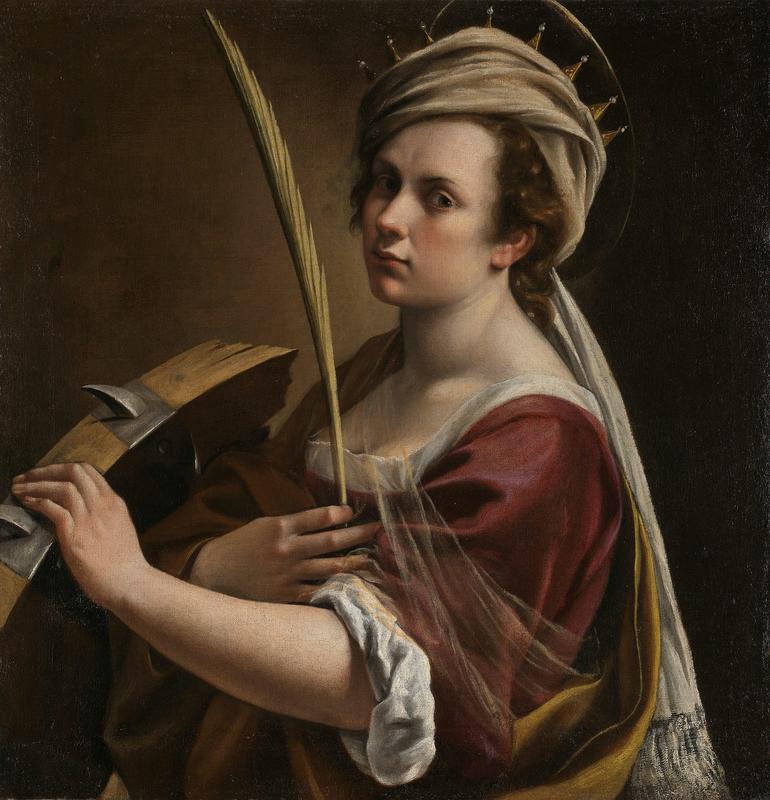More about Self-Portrait as Saint Catherine of Alexandria

Contributor
Fighting the patriarchy gets tiring after a while, especially when Artemisia Gentileschi’s Self Portrait as Saint Catherine of Alexandria is the first acquisition of a female artist by the National Portrait Gallery London since 1991.
This painting has received quite the attention as the London-based museum is put on blast for seemingly neglecting female artists in their collection. Not only was this painting the first in over twenty years to be purchased, it is one of only TWENTY-ONE works of art in the collection by female artists. Kids, we have a long way to go.
Artemisia Gentileschi was, despite her gender, one of the leading Baroque artists in the seventeenth century. Many of her paintings have been interpreted as self-portraits and her depiction of Saint Catherine was a frequent guest appearance in many of her proclaimed self-portrait paintings.
Gentileschi’s Self Portrait as Saint Catherine of Alexandria, showcases the fourth century martyr, Saint Catherine of Alexandria, who may indeed be a fictional character. No one really knows if this Catherine even existed, but she has been particularly canonized by the Orthodox church. This powerful, headstrong teenager, converted to Christianity at the young age of 14 and kinda messed with Emperor Maxentius for a period of time.
Emperor Maxentius was famous for executing Christians quickly and swiftly, but he took his time with Catherine. Probably listening with his penis, the Emperor gave the young Christian the opportunity to denounce her religion, even bringing in fifty of the the biggest, baddest, and oldest orators and philosophers of the Empire to debate her. Being the badass that she was, Catherine stole the show, winning the debate and infuriating the Emperor. His next plan? Try and marry her. Catherine said LOL and that she would rather die than marry him, which royally pissed off him and his man-pride. So, Catherine was sent to be tortured, but still refused to deny her faith. Frustrated, the Emperor ordered her execution on a breaking wheel. Did she die this way? Nope. Miraculously, Catherine did not die and was then sent to have her head cut off which, of course, did the trick.
Gentileschi inserts herself into this portrait as Saint Catherine who leans casually against a breaking wheel, as if to mock the Emperor and even maybe the male establishment of Gentileschi’s time, saying you can try, but you can’t break me. Saint Catherine's feast day is November 25 and she is the Saint of many professions, including students and unmarried girls.
Sources
- Gentileschi, Artemisia. Self Portrait as Saint Catherine of Alexandria. 1615-1617. National Portrait Gallery London, London, United Kingdom. Accessed October 9, 2018. https://www.nationalgallery.org.uk/paintings/artemisia-gentileschi-self…
- Kinsella, Eileen. "London’s National Gallery (Finally) Buys a Painting by Artemisia Gentileschi, Pioneering Female Artist of the Italian Renaissance." Artnet News, July 6, 2018. Accessed October 9, 2018. London’s National Gallery (Finally) Buys a Painting
- Locker, Jesse. "The National Gallery Acquires Its First Painting by a Woman Since 1991." Hyperallergic, July 12, 2018. Accessed October 9, 2018. The National Gallery Acquires Its First Painting by a Woman Since 1991.
- Catholic Online. "St. Catherine of Alexandria." Catholic Online. Accessed October 9, 2018. Jesse Locker, "The National Gallery Acquires Its First Painting by a Woman Since 1991," Hyperallergic, July 12, 2018, , accessed October 9, 2018, The National Galle
- The Editors of Encyclopaedia Britannica. "Srtemisia Gentileschi Italian Painter." Encyclopaedia Britannica.Accessed October 9, 2018. https://www.britannica.com/biography/Artemisia-Gentileschi.
- "Rare Self Portrait by Artemisia Gentileschi Enters the Collection." National Portrait Gallery London. Accessed October 9, 2018. https://www.nationalgallery.org.uk/paintings/rare-self-portrait-by-arte….
Featured Content
Here is what Wikipedia says about Self-Portrait as Saint Catherine of Alexandria
Self-Portrait as Saint Catherine of Alexandria is a 1615–1617 painting by the Italian Baroque artist Artemisia Gentileschi, showing the artist in the guise of Catherine of Alexandria. It is now in the collection of the National Gallery, London, which purchased it in 2018 for £3.6 million, including about £2.7 million from its American Friends group.
It was painted during Gentileschi's time in Florence, and is similar to her Saint Catherine of Alexandria (c. 1619), now in the Uffizi Gallery. It is one of several paintings of female martyrs that Gentileschi made after her famous 1612 rape trial, in which she (unlike the accused) was subject to torture to test the veracity of her testimony.
Check out the full Wikipedia article about Self-Portrait as Saint Catherine of Alexandria












